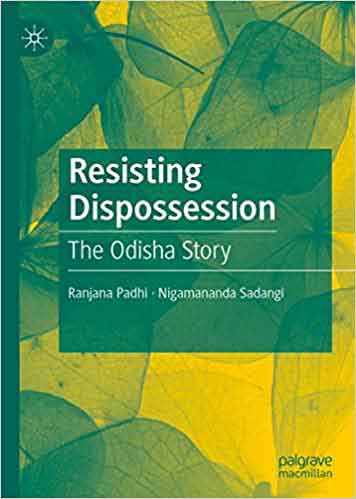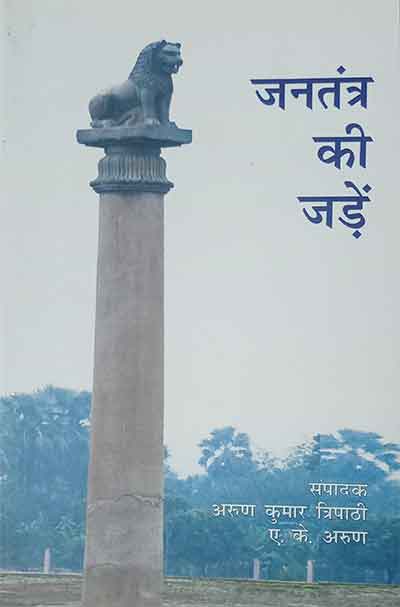
“Gaan Chhadiba nahin, jami chaddiba nahin”[i] a prominent war cry, echoed in the sacred mountains, rivers, and streams of various districts at different space and times, captures the essence of people’s resistance to land dispossession in Odisha. Ranjana Padhi and Nigamananda Sadangi’s latest book ‘Resisting Dispossession: The Odisha Story’ stands as a distinct repository of diverse lived experience, everyday struggles and manifold emotions like rage, sorrow, despair and strength of adivasis, Dalits, peasants and fisherfolk fueling the spirit of resistance movement from post independent Nehruvian state till contemporary neo liberal era. Mapping the history of people’s battle against mining, dam and corporate projects ranging from Hirakud in 1950s, BALCO till the coming of Vedanta and POSCO. The book records the voices of those who stood tall against dispossession in Hirakud, Rengali, Gandhamardhan, Baliapal, Chilika, Kashipur, Niyamgiri, Kalinganagar, Dhinkia and various other districts of Odisha. It provides a rich source understand people’s resistance to industrial projects and state administration from a caste, class, and gender framework.
As the book focuses on reading testimonies of resisting adivasis, dalits, peasants and fisherfolk, a panel discussion organized by the publisher Aakar books on 25th October 2020, added to this changing discourse on resistance and dispossession. The panel discussion had three speakers involved in people’s movement like Professor Manoranjan Mohanty, Bela Bhatia and journalist M.Rajshekhar. All three panelists spoke extensively on the relevance of recording such hard-fought battles of people and sharing their own lived experiences of the same. V Geetha, who moderated the event, called the book “a walk through of India’s changing political economy.” In her reading of the book, she felt humbled as reading the sage of resistance narrated by those affected by dispossession. Reading of different narrations was a humbling experience for her, just as people recall their struggles in each narrative from the past (Hirakud till Anti-POSCO movement) and keep the hope of the past alive in the present. For her, the book also pointed towards the changing nature of power with use of greater violence – use of paramilitary forces in curbing resistance of people, and the collusive relation between capital and the state which became more and more evident as different narratives of resistance moved in the book.
Panelists like Prof Manoranjan Mohanty, a well-known political scientist, civil and democratic rights activist who has written extensively on social movements, and currently interested in exploring the idea of a creative society ( and what does it mean to be politically creative?), contributed to the discussion by making major theoretical additions to the understanding of resistance to land displacement, dispossession in Odisha. Mohanty who has been actively involved in these struggles, lauded the authors for maintaining the authenticity of voices while mediating them in English. According to him, the book records the emergence of creative society where all humans have potential for creativity which were suppressed by caste, class, and patriarchal domination. He argued that, through these voices, it is evident that natural resources cannot be seen as property or wealth but collective ownership as they challenge the appropriation of it from colonial, neo colonial and global capital at different stages in history. For Mohanty, the book highlights the importance of women’s participation as being the main staff while constantly facing betrayal by patriarchal leaders. Also, it points towards women’s representation, their potential agency and patriarchal limitations imposed on them.
He argued that the failure of these movements to move the extractive capital ideology which is gradually becoming the dominant norm, lies in various compromises made by upper caste patriarchal leadership in these movements which made these single project movements confined to one area rather than bringing all the other movements together. He suggested that people’s movement provide a fundamental critique to the colonial development paradigm as they refuse to let capitalist development strategy to appropriate the people’s idea of development i.e. Right to Earth (the right to share resources).
Bela Bhatia, an advocate, and human rights activist based in Chhattisgarh, spoke extensively on the nature of state which has become increasingly predatory. She made linkages between her experience in Bastar to her reading of the book. Bhatia argued that nonviolence is always touted but one needs to look at how the state pushes people to violence and once people take up arms and stones there are no distinction drawn. She argued that people waged brave battles and state refused to listen to them when they were nonviolent like in Kalinganagar. Moreover, the state pushed them into violence, labelled them as “violent” people and ended up using paramilitary force on them with impunity. Interestingly, she added that the recent laws on UAPA and state laws like CSPA (Chattisgarh Special Public Security Act, 2005) gave special powers to police which is the most unaccountable institution in the country.
She pointed to the need for the state to listen to people and acknowledge that existing laws like PESA Panchayats (Extension to Scheduled Areas Act, 1996) and Forest Rights Act are laws for which the people fought with great human sacrifices. For her, the book goes a long way to map out people’s struggles and is in itself an act of resistance recording another history of the country that we wish to ignore, and the story that has certainly not ended. For Bhatia, the book puts people under center stage and reveals what democracy is not. Towards the end, she emphasized on taking this kind of work forward and to reiterate this land is ours, this country is ours, this democracy is ours!
M.Rajshekhar, a journalist who previously worked with Economic Times and recently did a series of reports titled ‘Ear To The Ground’ for Scroll on urban planning and emvironmental issues in states like Odisha, Tamil Nadu, Mizoram, Bihar and Gujarat, found the books extremely granular. He pointed towards a paradox of looking at these struggles as a major resistance to dispossession whereas being silent on other forms of dispossession such as state failure. His argument followed from his extensive reporting work from Gujarat, Tamil Nadu, Mizoram as well as Odisha, to ask why people protest some forms of dispossession while being silent on others such as education and healthcare systems. He insisted that people usually protest the kind of dispossession they recognize or are exceptionally blatant. He argued that there is a constant normalizing of state failure and a lot of dispossession and expropriations are not getting explained in the way people understand. As a result, people are protesting occasionally when they see or have lived experience of it.
Both the authors, Ranjana Padhi and Nigamananda Sadangi, beautifully revisited the process of writing, field research and reading experience that made the book an extremely unique and rare repository of people’s struggle against dispossession. As Sadangi disclosed that the idea with which they began, focused on recording people’s voices, sorrows, success, and failure with their productive assets being snatched away along with their identity that remains tied to their land subsistence. To this Ranjana added that one needs to look at these struggles from one’s own position and ask questions like what is one doing for these struggles? She critically looked at the working of capitalism in dividing people, who are the beneficiaries of neo liberalism but at the same time want to see Niyamgiri stand. The task confronting everyone is to push the entire edifice created by capitalism, to resist the corporations in order to protect the land. According to her, this fierce resistance to dispossession, an integral element of the edifice created by the capitalism is exactly what the people of Odisha have challenged and continue to do.
The panel discussion was attended by more than hundred people including scholars like Uma Chakravarti, Amita Baviskar and others who expressed their interest in grabbing a copy of the book. Nigam and Padhi announced the upcoming publications of the book in Odia titled Gaan Chadibu Nahin: Das Ti Jan Andolan Ro Gatha and the Hindi version, Gaon Chadob Nahin: Odisha ke Jan Andolanon ki Gatha.
Watch the discussion
https://www.youtube.com/channel/UCNj7uJNoE10F76se70xJdHw
[i] As mentioned in the book “a song composed and set to tune by Bhagaban Majhi, a leading activist of Prakurita Sampad Surakshya Parishad (PSSP) In Kucheidpadar, Kashipur. It became popular across all anti- displacement movement in India. (Ranjana Padhi, 2020)
Deeksha Sharma has a Master’s in Gender Studies from Ambedkar University, Delhi.
SIGN UP FOR COUNTERCURRENTS DAILY NEWSLETTER

















































